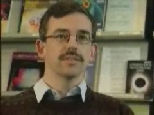ISO's Biggest Find: "Astro-Mineralogy"

Quicktime - 1.5 Mb 2:04mins Interview: Prof. Rens Waters, Amsterdam University, February 2000
|
A
whole new branch of astronomy is opening up as a result of discoveries
coming from ESA's Infra-Red Space Observatory.
ISO was launched into space to send back pictures of Infra-Red light sources in the Universe. Its latest discovery is thought to be its most important, centring on microscopic silicate crystals which are being found in large quantities around old stars, in proto-planetary discs and in our solar system. Experts, who are now being called "astro-mineralogists", believe they could turn out to be the building blocks of our solar system and are studying the crystals to try to determine their contribution to the formation of planets. |
|
Script
| ISO was able to spot the crystals as it looks for Infra-Red light. Silicate crystals generally exist at low temperatures and as cold materials give off mostly Infra-Red light, ISO was the only way of spotting them. The satellite's two on-board spectrometers were then able to work out the crystals' chemical fingerprint. | ||||
| Interview:
Rens Waters Amsterdam University |
"ISO was able to detect the presence of crystalline silicates, crystals made of Olivines and other materials around both old stars at the end of their lives and even more excitingly around young stars where we think that planets are being formed. And so for the first time we have an idea about the building blocks of planets, like our own solar system has been built of, around other stars and we learn a lot about the origin of our own solar system that way." | |||
| Silicate
crystals are the most abundant minerals on Earth and in our Solar System
but the discovery that they are so prevalent elsewhere in the universe
has come as a surprise. Experts are now studying the possible crystal-making
mechanisms. Thanks to ISO, scientists can start classifying silicates in
the Universe opening a brand-new research field: astro-mineralogy.
These same scientists believe that ISO really is fulfilling its promise to reveal the chemistry of the Universe! |
||||